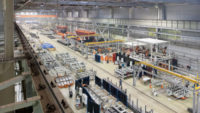AI-enabled Personal Protective Equipment (PPE) marks a groundbreaking evolution in workplace safety, blending traditional protective gear with advanced artificial intelligence. It is set to redefine safety standards across industries, especially in high-risk environments.
The advent of AI-enabled PPE offers an unprecedented level of situational awareness and proactive risk management, transforming how safety protocols are implemented and monitored. This technology enhances the protection of workers and streamlines safety management, making it a vital tool in modern occupational health and safety strategies.
The manufacturing landscape has already evolved dramatically, with technological advancements reshaping production processes and workplace environments. AI has emerged as a pivotal force in driving efficiency and innovation across various manufacturing sectors.
This transformation is not just limited to machinery and production techniques. It extends into worker safety, where AI integration is becoming more common.
AI's role in revolutionizing safety gear has been transformative, marking a new era in worker protection. Integrating AI into PPE has enabled manufacturers to create smart safety solutions that anticipate risks and adapt to changing environments. This has led to a significant reduction in workplace accidents and injuries, showcasing AI's potential in creating safer workspaces.
The introduction of AI PPE has shifted the focus from passive protection to active prevention, using data-driven insights to preemptively address potential hazards.
As a result, AI PPE has become a cornerstone in the safety protocols of modern manufacturing, changing the landscape of workplace safety management for the better.
Cutting-edge features of AI-enabled PPE
The latest AI-driven safety gear is equipped with features that are nothing short of revolutionary. These include real-time environmental monitoring, predictive risk analysis, and automated emergency response mechanisms.
Such capabilities enhance the immediate safety of the wearer and contribute to a broader understanding of workplace hazards, allowing for more effective safety planning and response strategies.
Companies have witnessed a significant decrease in workplace accidents and better compliance with safety protocols. The advancements are not just limited to theoretical models but have shown tangible benefits in various manufacturing environments, demonstrating the practical value and versatility of AI in enhancing worker safety.
AI-driven PPE and the connected worker ecosystem
By 2024, connected manufacturing technology will have become more sophisticated and integrated. This technology, which encompasses a network of interconnected devices and AI algorithms, has enhanced the way information is shared and processed in the workplace.
As one of the central components of this ecosystem, PPE has played a crucial role in elevating worker safety and operational efficiency.
The integration of AI PPE within the connected worker ecosystem represents a seamless blend of individual safety and collective data intelligence. This synergy has enabled real-time monitoring and data-driven decision-making, significantly improving response times to potential hazards.
In the construction industry, AI-enabled helmets have significantly reduced accident rates by offering real-time alerts about potential hazards. These AI-powered safety solutions continuously monitor construction sites, detecting risks and unsafe behaviors, such as incorrect PPE usage or entering danger zones.
Compliance and regulatory evolution in 2024
The influence of AI on safety regulations has been substantial, prompting regulatory bodies to revise and update existing standards. As AI PPE introduces new capabilities, such as predictive analytics and automated responses, regulators have had to consider these innovations in their policy formulations.
This has led to a more dynamic regulatory environment, with standards evolving to accommodate the advanced features of AI PPE. Regulatory bodies have had to balance innovation with safety, leading to the development of new guidelines that address the unique aspects of AI integration in PPE.
AI PPE's advanced features that go beyond traditional PPE capabilities have raised the bar for what constitutes adequate worker protection. This has not only influenced regulatory standards but also encouraged industries to adopt higher safety measures, fostering a culture of continuous improvement in occupational health and safety.
The impact of AI PPE on manufacturing practices
The contributions of AI PPE to enhancing manufacturing principles are multifaceted. The integration of AI into PPE has enabled a more data-driven approach to safety management, influencing operational decisions and fostering a safer, more productive work environment.
For instance, in automotive manufacturing, the implementation of AI-equipped safety vests has played a crucial role in reducing workplace injuries. The integration of smart wearables with AI and haptic feedback in these vests assists workers in maintaining ergonomic postures, significantly minimizing the risk of musculoskeletal disorders and related injuries.
This approach has been particularly effective in industries like logistics, warehousing, and manufacturing, where physical exertion and repetitive motions are common. The use of these advanced safety vests has not only improved worker safety but also reduced workplace injuries
Contemporary challenges and ethical considerations
Implementing AI PPE in the workplace comes with unique challenges and considerations. These include ensuring compatibility with existing safety protocols, managing the costs of implementation, and training workers to effectively use the new technology.
The use of AI PPE raises important questions about data privacy, ethical use, and worker acceptance. Concerns about the collection and use of personal data, ensuring that AI algorithms are free from bias, and gaining worker trust are central to these discussions. Balancing technological advancement with ethical considerations and user acceptance is key to the successful adoption of AI PPE.
Overcoming the challenges associated with AI PPE involves a combination of solutions and best practices. These include transparent communication with workers about data use, implementing robust data security measures, and providing comprehensive training programs.
The road ahead: predictions and emerging trends beyond 2024
Looking beyond 2023, the future of AI-enabled safety gear appears promising — with continuous advancements expected in both PPE technology and applications.
Emerging trends and potential innovations in AI PPE point toward more intuitive and interactive systems. Future developments may include augmented reality interfaces, greater integration with the Internet of Things (IoT), and more sophisticated machine learning algorithms.
These innovations are expected to make AI PPE more versatile and effective in an even wider range of work environments.
As AI PPE becomes more advanced and widespread, it is likely to set new benchmarks for what is considered adequate worker protection. This could lead to a redefinition of safety standards, with a greater emphasis on proactive risk management and personalized safety solutions.



